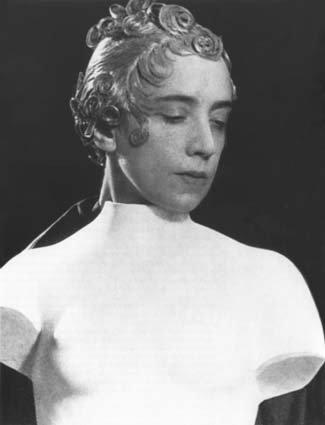Coco Chanel once dismissed her rival as ‘that Italian artist who makes clothes.’ (To Schiaparelli, Chanel was simply ‘that milliner.’)
Elsa Schiaparelli (september 10, 1890 – november 13, 1973) was born in Rome, Italy. She studied philosophy and at the age of 22 she accepted a job as a nanny in London. Elsa led a refined life with a certain amount of luxury provided by her parents’ wealth and high social status. She believed, however, that this luxury was stifling to her art and creativity and so she removed herself from the ‘lap of luxury’ as quickly as possible. She moved first to New York City and then to Paris, combining her love of art and design to become a couturier.
She was not a trained seamstress and her interest was not merely in fashion. She was a flamboyant persona who liked interacting with artists. She designed her clothes on paper, trusting her tailors to correctly interpret them, which was not as common then as it is today.
Elsa launched a collection of knitwear in 1927, after she made her first steps into fashion earlier, with some encouragement from Paul Poiret. The first collection featured sweaters with surrealist trompe l’oeil images which were published in Vogue. Her business really took off with a pattern that gave the impression of a scarf wrapped around the wearer’s neck.
Elsa’s ‘pour le Sport’ collection expanded the following year to include bathing suits, ski-wear, and linen dresses. The divided skirt, a forerunner of shorts, shocked the tennis world when worn by Lili de Alvarez at Wimbledon in 1931. She added evening wear to the collection in 1931, and the business went from strength to strength, culminating in a move from Rue de la Paix to acquiring the renowned salon of Madeleine Chéruit at 21 Place Vendôme, nicknamed the Schiap Shop.
Elsa collaborated with famous artist Jean Cocteau and Salvador Dalí to create her most significant designs. She was the most innovative and influential dress designer of the 20th century, known for her shocking designs and Surrealist influences in her haute couture. Her inventions included the color ‘Shocking Pink‘, which she made famous, the innovative use of colorful zippers, gadget accessories such as scarves of material with a newspaper print design and the clinging and attractive bias-cut dresses.

Elsa Schiaparelli & Salvador Dali
Elsa Schiaparelli & Jean Cocteau

Perhaps Schiaparelli’s most important legacy was in bringing to fashion the playfulness and sense of ‘anything goes’ of the Dada and Surrealist movements. She loved to play with juxtapositions of colours, shapes and textures, and embraced the new technologies and materials of the time. With Charles Colcombet she experimented with acrylic, cellophane, a rayon jersey called “Jersela” and a rayon with metal threads called “Fildifer” – the first time synthetic materials were used in couture. Some of these innovations were not pursued further, like her 1934 “glass” cape made from Rhodophane, a transparent plastic related to cellophane. But there were more lasting innovations; Schiaparelli created wraparound dresses decades before Diane von Furstenberg and crumpled up rayon 50 years before Issey Miyake’s pleats and crinkles. In 1930 alone she created the first evening-dress with a jacket, and the first clothes with visible zippers. In fact fastenings were something of a speciality, from a jacket buttoned with silver tambourines to one with silk-covered carrots and cauliflowers.
Elsa Schiaparelli clothes

Elsa Schiaparelli accessories

The failure of her business meant that Schiaparelli’s name is not as well-remembered as that of her great rival Coco Chanel, because she did not adapt to the changes in fashion following World War II. Soon after the fall of Paris on 14 June 1940, Elsa sailed to New York for a lecture tour; apart from a few months in Paris in early 1941, she remained in New York City until the end of the war. On her return she found that fashion had changed, with Christian Dior’s ‘New Look’ marking a rejection of pre-war fashion. The house of Schiaparelli struggled in the austerity of the post-war period, and Elsa finally closed it down in December 1954, the same year that Coco Chanel returned to the business. Aged 64, Elsa wrote her autobiography and then lived out a comfortable retirement between her apartment in Paris and house in Tunisia. She died on 13 November 1973.
Muccia Prada is inspired by Elsa Schiaparelli and surrealisme too.































3 Responses to “Elsa Schiaparelli is the one to whom the word ‘genius’ is applied most often”